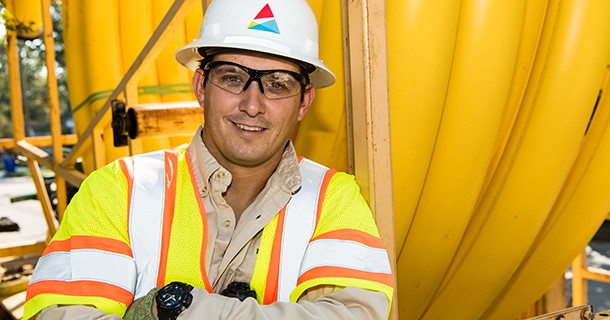Energy Efficiency Glossary
Below are some definitions to help you be more energy efficient:
AFUE (Annual Fuel Utilization Efficiency)
The most widely used measure of a furnace's heating efficiency, AFUE measures the amount of heat actually delivered compared to the amount of fuel supplied to the furnace. A furnace that has an 80 percent AFUE rating converts 80 percent of the fuel to heat. The other 20 percent is lost out of the chimney.
Alternative fuel
Popular term for "non-conventional" transportation fuels made from natural gas (propane, compressed natural gas, methanol, etc.), biomass materials (ethanol, methanol) or electricity.
British thermal unit (Btu)
The amount of heat required to raise the temperature of one pound of water one degree Fahrenheit; equal to 252 calories.
Carbon dioxide
A colorless, odorless noncombustible gas with the formula CO2 that is present in the atmosphere. It is formed by the combustion of carbon and carbon compounds (such as fossil fuels and biomass) and by respiration, which is a slow combustion in animals and plants, and by the gradual oxidation of organic matter in the soil.
CNG vehicle
A vehicle designed to operate on compressed natural gas.
Efficiency rating
This unit of measurement is the calculation of how much energy is used by appliances, water heaters, furnaces and other products. The higher the number, the more energy efficient the product is.
Emission
A substance that is given off; generally used in regard to discharges into the air or releases of gases into the atmosphere from some type of activity (cooking, driving a car, generating electricity, etc.). In the context of global climate change, emissions consist of greenhouse gases (e.g., the release of carbon dioxide during fuel combustion).
Energy
The ability to do work or the ability to move an object. Electrical energy is usually measured in kilowatt hours (kWh), while heat energy is usually measured in British thermal units (Btu).
Energy efficiency
Refers to activities that are aimed at reducing the energy used by substituting technically more advanced equipment, typically without affecting the services provided. Examples include high-efficiency appliances; efficient lighting programs; high-efficiency heating, ventilating and air conditioning (HVAC) systems; and efficient building design.
Energy Factor (EF)
An energy factor is a metric used to rate and compare the energy conversion efficiency of residential appliances and equipment.
ENERGYSTAR
A program from the U.S. Environmental Protection Agency and the U.S. Department of Energy that helps the public save money and protect the environment through energy-efficient products and practices.
Federal Energy Regulatory Agency (FERC)
Federal government agency that regulates and oversees energy industries in the economic, environmental and safety interests of the American public.
Fossil fuels
Fuels -- natural gas, coal, oil, etc. -- formed over millions of years from the compression of ancient plant and animal life.
Fuel
Any material that can be burned to make energy.
Gas
(1) A non-solid, non-liquid (such as hydrogen or air) substance that has no fixed shape and tends to expand without limit. (2) A state of matter in which the matter concerned occupies the whole of its container irrespective of its quantity. Includes natural gas, coke-oven gas, blast furnace gas and refinery gas.
Gasoline
A complex mixture of relatively volatile hydrocarbons with or without small quantities of additives, blended to form a fuel suitable for use in spark-ignition engines.
Greenhouse gas emissions
Waste gases given off by industrial and power plants, automobiles and other processes.
Greenhouse gases
Gases that trap the heat of the sun in the Earth's atmosphere, producing the greenhouse effect. The two major greenhouse gases are water vapor and carbon dioxide. Lesser greenhouse gases include methane, ozone, chlorofluorocarbons and nitrogen oxides.
HVAC
Heating, ventilating and air conditioning system
Mercaptan
An organic chemical compound that has a rotten egg-like odor that is added to natural gas before distribution to the consumer to give it a distinct, unpleasant odor. Natural gas is odorless and colorless so mercaptan is a safety device that allows natural gas to be detected in the atmosphere if a leak should occur.
Methane
A colorless, flammable, odorless hydrocarbon gas (CH4) that is the major component of natural gas.
Natural gas
An odorless, colorless, tasteless, non-toxic fossil fuel found in abundant supply in the United States. Natural gas is the cleanest-burning fossil fuel with 45 percent fewer CO2 emissions than coal.
Nonrenewable fuels
Fuels that cannot be easily made or "renewed” such as oil, coal and natural gas.
Offshore reserves
Sources of oil and natural gas reserves that are located offshore; are under state or federal jurisdiction.
Oil
A black liquid fossil fuel found deep in the Earth. Gasoline, furnace oil, most plastics and other petroleum products are made from oil.
Outer Continental Shelf
Offshore area with oil and natural gas reserves that is under the jurisdiction of the federal government.
Particulates
Tiny particles of solid or liquid suspended in a gas or liquid; also called particulate matter
Petroleum
Generally refers to crude oil or the refined products obtained from the processing of crude oil (gasoline, diesel fuel, heating oil, etc.)
Pipeline
Conveys natural gas or gasoline.
Refinery
An industrial plant that transforms crude oil (petroleum) into products such as gasoline, kerosene, fuel oil, asphalt, lubricating oils, diesel fuels, etc.
Renewable energy
Fuels that can be easily made or "renewed” such as hydropower (water), solar, wind, geothermal and biomass.
Solar energy
The radiant energy of the sun, which can be converted into other forms of energy, such as heat or electricity.
Thermostat
A device that adjusts the amount of heating and cooling in a home or building. Programmable thermostats can be set to save energy by reducing or increasing temperatures automatically at certain times.
Weatherization
The practice of protecting a building and its interior from the elements, particularly from sunlight, precipitation and wind, and of modifying a building to reduce energy consumption and optimize energy efficiency.
Weather stripping
The process of sealing openings such as doors and windows from the elements to prevent rain and water from entering and to keep interior air in, thus saving energy with heating and air conditioning.
Sources: Energy Information Administration; The Department of Energy



